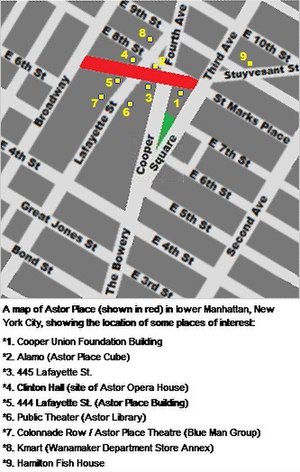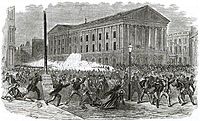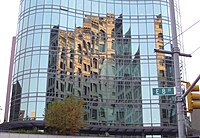Astor Place: Difference between revisions
| Line 33: | Line 33: | ||
==In popular culture== |
==In popular culture== |
||
*Astor Place is mentioned in the song ''New York City Don't Mean Nothing'' by [[Savatage]]. |
*Astor Place is mentioned in the song ''New York City Don't Mean Nothing'' by [[Savatage]]. |
||
*In [[Spider-Man 2]], the cafe from which Dr. Octopus abducts Mary Jane is at the intersection of Astor Place and [[Lafayette Street]]. |
|||
==Gallery== |
==Gallery== |
||
Revision as of 18:38, 4 July 2012
40°43′47″N 73°59′29″W / 40.729861°N 73.991434°W

*1. Cooper Union Foundation Building
*2. Alamo (Astor Place Cube)
*3. 445 Lafayette St.
*4. Clinton Hall (site of Astor Opera House)
*5. 444 Lafayette St. (Astor Place Building)
*6. Public Theatre (Astor Library)
*7. Colonnade Row / Astor Place Theatre (Blue Man Group)
*8. Kmart (Wanamaker Department Store Annex)
*9. Hamilton Fish House
Astor Place is a short two-block street in lower Manhattan, New York City, which runs from Broadway just below East 8th Street, through Lafayette Street, past Cooper Square and Fourth Avenue, and ends at Third Avenue and St. Mark's Place. The name is also used for the neighborhood around the street.[1] It is named for John Jacob Astor, at one time the richest person in the United States, who died in 1848; the street was named for him soon after.[2]
Astor Place was the site of the Astor Opera House at the intersection of Astor Place, East 8th Street and Lafayette Street. Built to be the fashionable theater in 1847, it was the site of the Astor Place Riot of May 10, 1849. Anti-British feelings were running so high among New York's Irish at the height of the potato famine that they found an outlet in the rivalry between American actor Edwin Forrest and the English William Charles Macready, who were both presenting versions of Macbeth in nearby theatres. The protest in the streets against Macready became so violent that the police fired into the crowd. At least eighteen died and hundreds were injured. The theater itself never recovered from the association with the riot and was closed down shortly afterwards. The interior was demolished and the building was turned over to the use of the New York Mercantile Library.
In the mid- to late-18th century, the area was home to many of the wealthiest New Yorkers, including members of the Astor, Vanderbilt and Delano families. Editor and poet William Cullen Bryant and inventor and entrepreneur Isaac Singer lived in the neighborhood in the 1880s.[3] By the turn of the century, however, warehouses and manufacturing firms moved in, and the elite moved out. The neighborhood fell into disrepair, but was revitalized beginning in the late 1960s and 1970s.[1]
Points of interest
The current 299-seat Off-Broadway Astor Place Theatre, has been located in the landmark Colonnade Row on Lafayette Street, half a block south, since 1969. It was known for premiering works by downtown playwrights like Sam Shepard, but since 1991 has been the home of Blue Man Group, which now owns the theatre. The Joseph Papp Public Theater (home to the New York Shakespeare Festival) is located across the street in the former Astor Library building.
The trapezium-shaped traffic island in the center of Astor Place is a popular meeting place, hangout spot, and center of much skateboarding activity. But the island is most notably home to Tony Rosenthal's sculpture "Alamo", known popularly as "The Cube", which consists of a large, black metal cube mounted on one corner. The sculpture can be spun on its vertical axis by one person with some effort, and two or more people without trouble. In 2003, the cube was the subject of a prank played by the ATF squad (All Too Flat) in which it was turned into a giant Rubik's Cube. The members of the organization were careful with the prank, as they didn't want to be destructive. The cube stayed up for about 24 hours before NYC maintenance removed the painted cardboard panels from the sculpture. "The Cube" was taken away for repairs in September, 2005, and for a short time a makeshift memorial out of white tubes replaced it. It was restored in December, 2005, and is still able to spin.
Historic places
- In 1860, Abraham Lincoln came to the attention of the fledgling Republican party with his Cooper Union Address. Given in The Cooper Union's Great Hall, the 'Right Makes Might' speech examined federal control of slavery and the thoughts of the signers of the Constitution. Cooper Union also housed one of the first free public libraries.
- One of the original libraries making up the New York Public Library, the Astor Library was housed in the Astor Library Building. The building is home today to Joseph Papp Public Theater.
- The Astor Place subway station is among the original 28 subway stations, and is on the List of Registered Historic Places in New York. The tile mosaics on the station platform feature beavers, a tribute to John Jacob Astor, whose fortune was founded in beaver-pelt trading.
- The Peter Cooper Memorial by Augustus Saint Gaudens is one block south on Cooper Square.
- 21 Astor Place (also known as "Clinton Hall" and "13 Astor Place") stands on the site which was once the Astor Opera House. After the Astor Place riot, the building was turned over to the New York Mercantile Library, which used it until 1890, when they tore it down and built the current 11-story building. The Library left in 1932, and the building became the headquarters for a union. It has now been redeveloped into modern condominIums behind the original 19th century façade, an example of the technique of facadism.[4]
- The Cooper Station Post Office, built in the 1920s, is just three blocks north.
In popular culture
- Astor Place is mentioned in the song New York City Don't Mean Nothing by Savatage.
- In Spider-Man 2, the cafe from which Dr. Octopus abducts Mary Jane is at the intersection of Astor Place and Lafayette Street.
Gallery
-
The Astor Library, seen in a 1900 drawing, opened in 1849. It is now the Joseph Papp Public Theatre
-
The Astor Place riot in 1849: anti-British feelings expressed in a dispute over competing productions of Macbeth; the Astor Opera House is in the background
-
After the riot, the Opera House closed and the building was turned over to the New York Mercantile Library, who later built this 11-story building on the site
-
The Cooper Union Foundation Building has stood on Astor Place, anchoring the north end of Cooper Square, since 1859
-
The Astor Place Building at 444 Lafayette Street was built in 1876...
-
...while across the street stands the modern condominium building at 445 Lafayette (2004)
-
The beaver in the Astor Place subway station is a tribute to John Jacob Astor, whose fortune was founded on beaver-pelt trading
-
Tony Rosenthal's Alamo, behind it, Kmart, in the building that was once the annex to the giant Wanamaker's Department Store
See also
References
- Notes
- ^ a b Elsroad, Linda. "Astor Place" in Jackson, Kenneth T., ed. (1995). The Encyclopedia of New York City. New Haven: Yale University Press. ISBN 0300055366. p.64
- ^ Moscow, Henry (1978). The Street Book: An Encyclopedia of Manhattan's Street Names and Their Origins. New York: Hagstrom Company. ISBN 978-0-8232-1275-0.
- ^ Federal Writers' Project (1939). New York City Guide. New York: Random House. ISBN 978-1-60354-055-1. (Reprinted by Scholarly Press, 1976; often referred to as WPA Guide to New York City.), pp.121-122
- ^ Nadine Brozan, POSTINGS: On a Triangular Site at 21 Astor Place; 50 Ultramodern Condominiums Behind an Exterior From 1890, The New York Times, April 6, 2003
External links
- www.publictheater.org - Free Shakespeare in the Park
- Demolished Broadway theatres
- The Astor Place Riot
- The prank(With pictures)
- Pictures of the Cube being removed (The Cube was removed on March 8, 2005, restored, then returned on November 18, 2005.)
- Lincoln's Cooper Union Address








